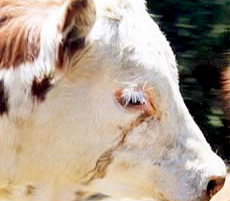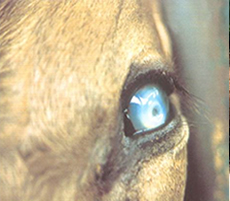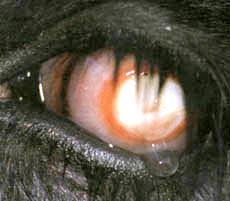A number of micro-organisms can contribute to the establishment of Infectious Bovine Keratoconjunctivitis (IBK), Cattle Pinkeye, or Blight. These may be viral or bacterial (including Mycoplasma spp).
What is pinkeye?
The primary infectious agent involved in pinkeye is the bacterium Moraxella bovis, which is carried in the nasal and ocular (eye) secretions of carrier animals. M. bovis attaches to the surface of the eye using pili and damages it by producing toxins and haemolysins which erode the cornea and cause ulceration and severe inflammation.Flies play an important role in physically transferring the infective organism from infected to naïve non-infected stock.
Pinkeye is considered to be an economically important disease throughout Australia. A recent Meat and Livestock Australia (MLA) report estimates that the disease costs Australian beef farmers $23.5 million annually in lost production and treatment costs. 
Coopers PILIGUARD pinkeye 1-trivalent vaccine
- The only commercially available vaccine against Moraxella bovis in Australia*
- Single dose vaccine
- Formalin inactivated cultures of three M. bovis isolates in an oil emulsion adjuvant
- Aids in the prevention of pinkeye associated with infection by M. bovis strain expressing pili similar to those expressed by the isolates used in the production of the vaccine (FLA 64, SAH 38, EPP 63)
Economic cost of pinkeye
Pinkeye is estimated to cost Australian beef producers over $23 million in lost production and treatment costs annually1. The real cost of pinkeye can be much greater because cattle that have been affected by pinkeye have a far greater chance of being downgraded and rejected at sale time. This reduced market access is critical to producers.
Animals that are showing signs of pinkeye infection or scarring can be:
- Rejected by many feedlots
- Discounted at saleyards
- Not attractive to stud operators
Economic costs
Production Losses: Pinkeye prevalence may vary on individual farms from year to year. One of the greatest challenges of pinkeye is the significant impact on farm
productivity.
Productivity losses can include:
- A reduction of between 3-5% in sale weights of affected young stock1
- Decreased milk production
- Negative effect on heifer fertility2
- An increase in the death rate of weaners1
All stock under 2 years old are highly susceptible to pinkeye. These are also your most valuable animals into the future and should be protected from pinkeye.
Meat and Livestock Australia (2006). Assessing the economic cost of endemic disease on the profitability of Australian beef cattle and sheep producers, MLA Final Report.
Predisposing factors for the development of pinkeye
- Flies – responsible for spread of the bacteria between animals
- Ultraviolet light – sensitises and can damage the cornea
- Long grass – causes physical damage and can cause mechanical transmission
- Dust – irritates eyes, increases tear production and assists spread
- Pigmentation – pinkeye is generally more common in non-pigmented eyes
- More common in Bos taurus than Bos indicus cattle
- Overcrowding (e.g. cattle congregating for drought feeding, yard weaning)
- Immune status - cattle in poor body condition tend to be less able to mount a protective immune response against the bacteria. Prior exposure leads to immunity, hence disease is more common in young stock. Adult stock are still susceptible if they have not been previously infected. Herd outbreaks were observed in Tasmania when the disease was first introduced.
Clinical signs of pinkeye
- Increased lacrimation (increased tear production) is often the first sign seen
 |
| Early stages of pinkeye in a young Hereford calf |
- The cornea becomes cloudy and a white spot can appear in the centre
- Some cases clear at this stage but others progress to corneal ulceration and the cloudiness covers the whole cornea

- The eye changes from a white to a pink to a yellow colour
 |
- Some of these eyes will return to normal following treatment, some will resolve with no treatment, some develop a small white scar and others are left permanently blind
Treatment
- Eye ointment, powders, sprays – often work in the early stages of the disease

- Antibiotic injections – several are registered for treatment of pinkeye
- Patches – glued on to cover the eye and protect it from dust, flies and ultraviolet light after treatment
- Surgery – sometimes required to remove eye if eye ruptures, or to suture the eye closed after treatment
Prevention
- Historically in Australia, prevention of pinkeye has centred on management factors to limit fly numbers and to limit the exposure of susceptible cattle to dusty conditions and infected animals. With the introduction of Piliguard these husbandry factors are still important but the cattle producer has another weapon in the fight against pinkeye
- Vaccinate animals with Piliguard 3-6 weeks before the onset of the pinkeye season
- Use other management tools to control the spread of pinkeye in your herd:
- Fly control - Integrated Pest Management incorporating the use of Coopers Easy-Dose
- Treat clinical cases early – this will decrease the number of infective bacteria in the herd and limit spread
- Segregate affected animals and try to avoid yarding them in dry, dusty conditions so as to minimise transmission to susceptible animals
Acknowledgement
This article is courtesy of Coopers Animal Health.
1. Meat and Livestock Australia (2006). Assessing the economic cost of endemic disease on the profitability of Australian beef cattle and sheep producers, MLA Final Report.
2. Burns BM, Howitt CJ, Esdale CR (1998). Bovine infectious keratoconjunctivitis in different cattle breed. Proceedings of the Australian Society of Animal Production 17:150-153.
® Registered trademark.



